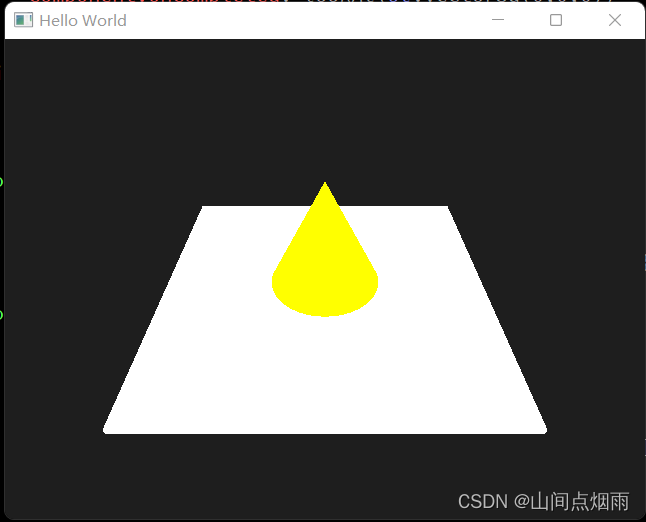2. QML使用View3D控件显示三维模型
1. View3D介绍
View3D控件和QML中其它控件类似,只是在其中可以显示三维模型,类似在界面中创建一个场景,所有的模型将在这个场景中被加载出来。
效果展示:
View3D三维模型加载
1.1 常用属性介绍
camera:相机(三维场景中加入相机,才能显示三维模型,控制相机的姿态进而控制三维模型的姿态)
PerspectiveCamera:透视相机,可以模拟人眼所看到的景象,可以显示物体的真是投影,用的较多
OrthographicCamera:正投影相机,平行投影没有视角缩放,可理解为2D相机
FrustumCamera:视锥体相机
CustomCamera:自定义相机
environment :设置场景环境,一般使用 SceneEnvironment
importScene:值类型为 Node 类型,用于设置需要渲染的东西,Node类型可以理解为一个Item,方便对多个组件进行控制。
renderMode :场景渲染模式
View3D.Offscreen
View3D.Underlay
View3D.Overlay
View3D.Inline
2. 场景中添加必要组件
在场景中除了添加相机外,还需要添加灯光和模型本身,如果不添加灯光,及时添加了模型,也无法显示,看到的时黑乎乎的屏幕。
2.1 灯光介绍
DirectionalLight:工作原理类似于太阳,可以在场景中均匀投射灯光
DirectionalLight {
//eulerRotation:控制坐标轴的旋转角度
eulerRotation.x: 200
eulerRotation.y: 20
//castsShadow设置为 true ,将会显示阴影效果
castsShadow: true
}
PointLight:点光源,类似于将光源定位在某一个位置点,在这个位置点发射光线
PointLight {
position: Qt.vector3d(100, 100, 150) //设定光源的位置点
castsShadow: true //开启阴影效果
}
SpotLight :聚光灯,在某一个方向上发生光锥形式的光线,形式类似于家里安装的小射灯样式。
SpotLight {
position: Qt.vector3d(50, 200, 50)
eulerRotation.x: -90
brightness: 5 //控制光源的强度,每一个光源都有这个属性
ambientColor: Qt.rgba(0.1, 0.1, 0.1, 1.0) //控制光源照亮前应用与材质的基色,每一个光源都有这个属性
castsShadow: true
}
2.2 模型加载
加载模型使用 Model 组件,在这个组件中必须要设置的属性是 source 和 materials ,即模型路径来源和材质。
source:url (内置的几个模型可以直接以字符串形式给出,包括:“#Rectangle"矩形,”#Sphere"球体,“#Cube"立方体,”#Cone"圆锥体,"#Cylinder"圆柱体)
materials:CustomMaterial, DefaultMaterial, and PrincipledMaterial
例如:在一个 Node 组件中添加光照,模型
Node {
id: standAloneScene
//! [rootnode]
DirectionalLight {
ambientColor: Qt.rgba(1.0, 1.0, 1.0, 1.0)
}
Model {
source: "#Cube"
y: -104
scale: Qt.vector3d(3, 3, 0.1)
eulerRotation.x: -90
materials: [
DefaultMaterial {
diffuseColor: Qt.rgba(0.8, 0.8, 0.8, 1.0)
}
]
}
}
3. 加载三维模型框架一:
将上述的所有组件都单独写入到 View3D 组件中,这样有个缺点:不方便统一控制组件。示例代码如下:
import QtQuick 2.15
import QtQuick.Window 2.15
import Qt.labs.qmlmodels 1.0
import QtQuick.Controls 2.5
import QtQuick.Controls 1.4
import QtQuick.Layouts 1.15
import QtQuick.Controls.Styles 1.4
import QtQuick3D 1.15
ApplicationWindow {
id:root
width: 640
height: 480
visible: true
title: qsTr("Hello World")
View3D{
anchors.fill: parent
environment: SceneEnvironment{ //设定渲染环境
clearColor: "#1e1e1e"
backgroundMode: SceneEnvironment.Color
}
PerspectiveCamera{ //设定相机
position: Qt.vector3d(0,250,300)
Component.onCompleted: lookAt(Qt.vector3d(0,0,0))
}
DirectionalLight{ //设定光源
ambientColor: Qt.rgba(1.0,1.0,1.0,1.0)
}
Model{ //加载模型一
position: Qt.vector3d(0,0,0)
source: "#Cone"
materials: [PrincipledMaterial{baseColor: "yellow";}]
}
Model{ //加载模型二
position: Qt.vector3d(0,-10,0)
scale: Qt.vector3d(3,3,0.05)
eulerRotation.x:90
source: "#Cube"
materials: [PrincipledMaterial{baseColor: "white";}]
}
}
}
3.1 运行效果:
4. 加载三维模型框架二:
以设置属性的方式,将相关组件设定为 View3D 的属性值,此时需要用到上述提及到的 Node 组件,便于对组件统一控制。示例代码如下:
import QtQuick 2.15
import QtQuick.Window 2.14
import QtQuick3D 1.15
import QtQuick.Controls 2.14
Window {
id: window
width: 1280
height: 720
visible: true
title: "View3Ds with Different Cameras"
Node { //节点,不可见控件
id: standAloneScene
DirectionalLight {
ambientColor: Qt.rgba(1.0, 1.0, 1.0, 1.0)
}
OrthographicCamera {
id: cameraOrthographicLeft
x: -600
eulerRotation.y: -90
}
Model {
source: "#Cube"
y: -104
scale: Qt.vector3d(3, 3, 0.1)
eulerRotation.x: -90
materials: [
DefaultMaterial {
diffuseColor: Qt.rgba(0.8, 0.8, 0.8, 1.0)
}
]
}
Model {
source: "teapot.mesh"
y: -100
scale: Qt.vector3d(50, 50, 50)
materials: [
PrincipledMaterial {
baseColor: "#41cd52"
metalness: 0.75
roughness: 0.1
specularAmount: 1.0
indexOfRefraction: 2.5
opacity: 1.0
}
]
PropertyAnimation on eulerRotation.y { //添加旋转动画
loops: Animation.Infinite
duration: 5000
to: 0
from: -360
}
}
}
Rectangle {
id: topLeft
anchors.centerIn: parent
width: parent.width * 0.5
height: parent.height * 0.5
color: "#848895"
border.color: "black"
View3D {
id: topLeftView
anchors.fill: parent
importScene: standAloneScene
camera: cameraOrthographicLeft
}
Label {
text: "三维模型加载"
anchors.top: parent.top
anchors.left: parent.left
anchors.margins: 10
color: "#222840"
font.pointSize: 14
}
}
}
4.1 运行效果:
View3D三维模型加载
